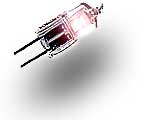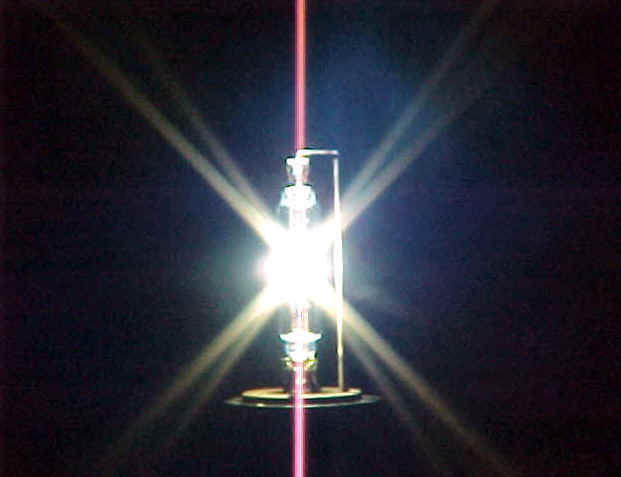Bulb Technology
The halogen bulb
The light is produced as in a normal incandescent bulb by a tungsten element. The color temperature is approx 3200° K . The trick is in the gas filling the bulb. Halogens are aggressive gasses, that combine with metals to form salts. In a halogen bulb that contains a small quantity of a halogen, the halogen combines with the boiled off tungsten to form tungstenhalogenide. On the surface of the tungsten element, temperatures are so high that the tungstenhalogenide comes out of solution and deposits the tungsten back on the tungsten element freeing up the halogen to repeat the process with the next bit of boiling tungsten. High temperatures are necessary to prevent the boiled off tungsten from settling on the inside of the glass bulb. This is achieved by making the bulb very small and keeping the glass surfaces near the tungsten element. This is a major advantage of halogen bulbs, but due to the high temperatures special glass must be used for the bulbs. The bulbs should not be touched by your hands since the oil contained in fingerprints will burn in and damage the bulb. The physical trick consists of confronting the boiling pressure of the tungsten element with a gas pressure. Heavy gases are necessary. Unfortunately due to the high reactivity of the hot metal only the ideal gases Krypton and Xenon can be used, at high cost. Advantages of halogen bulbs are relatively low cost and ease of use. Disadvantages are low color temperature, high current needed and short lifespan.
The HID bulb
Otherwise known as gasdischarge lamps, halogen metallic gas lamps, metal halide lamps etc. Light is produced by HID lamps in a different fashion than by halogen lamps. HID lamps don’t have an element, the light is produced by a arc. The arc is enclosed in a quartz glass between 2 tungsten electrodes. The arc temperature reaches 6500° C. By adding special gasses to the gas in the bulb the light intensity and color temperature can be adjusted. HID lamps require an electronic ballast and igniter to initiate the ignition of the bulb and and control the burning of the lamp. Lifespan of the HID bulb is high but is influenced by consumption of the electrodes and the chemical processes inside the bulb. HID bulbs produce all their light in a tightly concentrated spot between the electrodes and are a spot light source that is ideal for use as an underwater light source.
The Semiconductor lamp
In the semiconductor technology light is produced in a solid by recombining electrons with electron deficient areas on the crystalline structure and emitting the freed energy as light. The creation of light by electrical current takes place at room temperature ( the light emitting substance stays cold). This process is very efficient, the difficult p art is in getting the light out of the substrate with low losses. Lifespan and reliability are exceptionally high, since the light is produced at low temperatures without chemical or physical changes to the semiconductor.
art is in getting the light out of the substrate with low losses. Lifespan and reliability are exceptionally high, since the light is produced at low temperatures without chemical or physical changes to the semiconductor.